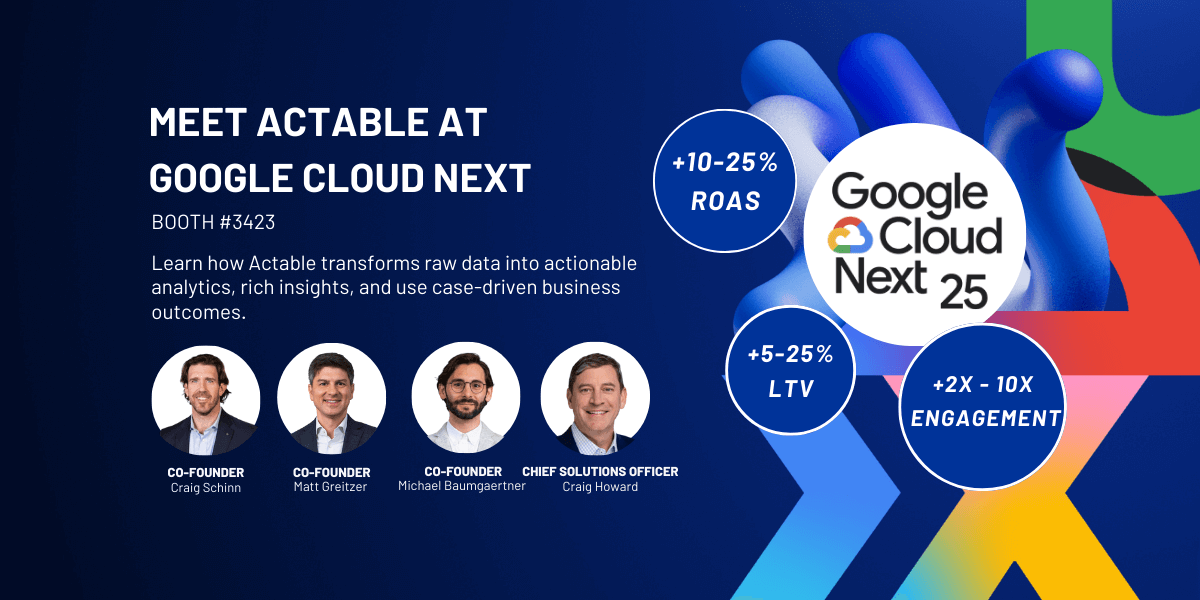In the market for a customer data platform (CDP)? Learn what steps to take when considering the introduction of a CDP into your marketing suite from Actable’s co-founder Craig Schinn.
Introduction
With all the hype around customer data platforms one could be forgiven for thinking that every organization has signed on with a CDP. The reality, however, is that many companies have yet to jump on the CDP bandwagon, and many are asking if they need to invest in yet another addition to their already complex martech stack. With close to 100 potential providers, the selection process can be onerous. And CDP installation itself is a commitment requiring both time and cross-departmental organizational commitment. How is one to know if that time, effort, and expense is worth it?
The Pre-CDP POC
There is, in fact, a low-cost, lightweight project that any company can undertake to make this assessment. This proof of concept for CDP implementation, or “Pre-CDP POC,” as we call it, allows one to mimic the benefits of a CDP installation (albeit in a limited manner) in the areas of data aggregation, segmentation and targeted deployment. This process also allows one to assess data readiness, internal resource requirements and potential business outcomes. In effect, the pre-CDP POC allows one to quantify the costs and benefits of a CDP installation to inform a business case either for or against. Here’s how it works:
- Data Discovery
- The first step in data enablement is to understand the data you actually have, where it lives, and how you can access it. There are obvious data sources, such as web analytics, email service providers, and customer data warehouses. But also less obvious sources such as call center data, warranty cards, information captured at marketing events, etc. In this process you should also develop an understanding of how the data are accessed, what resources or infrastructure you have available for enabling that access, and how data are permissioned for marketing purposes.
- If you are a small organization this may be straightforward work. But if your organization is of significant scale, has multiple divisions, or was formed via multiple acquisitions, this will be much more complex. There is opportunity in this endeavor as a means to an end, but also as an end in and of itself. You will also develop a fairly comprehensive map of your company’s data assets and gain a better understanding of what departments and functions need to interoperate in order to make a data-enabled strategy a reality. (Helpful hint here: if your organization has prepared effectively for CCPA compliance, much of this legwork has already been done by your legal department).
- Use Case Development
- Now that you have an understanding of your data assets, you can begin to develop use-cases that marry data with actionability – generally with the goal of driving a better business outcome. At the core, CDP functionality synthesizes customer actions and to enrich segmentation schemes and power deliberate, targeted messaging. Building use-cases is your plan for tying that data to actions and outcomes. We are proponents of the “crawl, walk, run” approach here, so simple use-cases will suffice, and can produce outsized impact. Some typical early-state POC use-cases include:
- Tying web site analytics data to known users to discern key site behaviors that drive customer value
- Identifying existing customers and suppressing them from acquisition advertising
- Identifying attributes of your best customers and creating look-alikes within your existing customer base
- Targeting a segment of customers with a winback, cross-sell, or upsell offer across email, ads, and if possible, site.
- Use cases require a solid testing plan to measure incremental impact. This is often accomplished with a simple test and hold-out group method, and should be built into your plan.
- Now that you have an understanding of your data assets, you can begin to develop use-cases that marry data with actionability – generally with the goal of driving a better business outcome. At the core, CDP functionality synthesizes customer actions and to enrich segmentation schemes and power deliberate, targeted messaging. Building use-cases is your plan for tying that data to actions and outcomes. We are proponents of the “crawl, walk, run” approach here, so simple use-cases will suffice, and can produce outsized impact. Some typical early-state POC use-cases include:
- Activation
- It’s time to turn your hypotheses into action via deployment across marketing channels. The use-cases defined in step 2 take life here. You may not have a CDP, but it’s surprising how elucidating it can be to measure the impact of some basic CDP use cases. The way Actable tries to set up the Activation phase places minimal burden on your marketing teams. We will build the targets in your ad platforms, ESP, and other in-scope channels. Your channel marketers will basically have a business-as-usual workload. For example, your acquisition team is already buying ads in Facebook & Google. Actable will simply provide them with a new audience to target. We will make clear recommendations on campaign taxonomy and any parameters to be passed through on click events.
- Results & Projections
- You may realize that there is a clear business case for bringing a CDP in to the mix. These tools are great at identity resolution and making 1st party data actionable across channels. Alternatively, you may find there is low-hanging fruit from simply using your existing tools & data in creative ways. You may also find that some of your existing stack provides some underutilized functionality that gets you the majority of the way there. What’s important is knowing the incremental value and applications of using your 1st party data. With a properly structured test, Actable can help you:
- Estimate the size of the opportunity
- Project ROI
- Roadmap use cases for a full deployment
- You may realize that there is a clear business case for bringing a CDP in to the mix. These tools are great at identity resolution and making 1st party data actionable across channels. Alternatively, you may find there is low-hanging fruit from simply using your existing tools & data in creative ways. You may also find that some of your existing stack provides some underutilized functionality that gets you the majority of the way there. What’s important is knowing the incremental value and applications of using your 1st party data. With a properly structured test, Actable can help you:
So if you’re thinking about running a complex vendor evaluation with uncertain use cases, consider the value of determining the data, use cases, and business case first. Bootstrapping with a Pre-CDP POC is a valuable way to determine which vendor might be the best fit based on your specific pain points and use cases.








